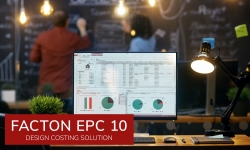FACTON Announces New Features to Keep Product Costs in Check Together: Version 10 of the FACTON EPC Design Costing Solution
FACTON, the leader in Enterprise Product Costing (EPC), today announced the release of version 10, the latest of its FACTON EPC Design Costing solution. The solution for design costing in the FACTON Enterprise Product Costing (EPC) Suite offers a range of enhancements.

Potsdam, Germany, November 21, 2018 --(PR.com)-- The cost structures of products that are produced and marketed internationally are increasingly complex. The only way to remain competitive in the long run is to have a clear overview of costs as early as the development stage. After all, up to 80 percent of all product costs are determined during this phase. FACTON EPC 10 Design Costing helps identify cost drivers early in development stage-based costing.
“Having Design Costing as a part of our EPC Suite immediately shows users the impact that design- and product-related decisions have on final product costs,” explains FACTON CEO Alexander M. Swoboda. “Target costs are stored in the system, making it easy to quickly identify savings potential and perform direct comparisons with suitable alternatives.”
One of the most significant enhancements to FACTON EPC 10 Design Costing is the option of linking the application so that it can interact with the Should Costing EPC Suite solution. “We help companies perform costing across multiple departments so that they can more effectively identify savings potential. The new version enables development and purchasing to collaborate even more efficiently within the costing system. Breaks in media are a thing of the past and users can take better advantage of synergies from both solutions,” adds Swoboda.
Since all the relevant data is stored in an unified system, users can focus on costing – data acquisition is no longer required. This keeps administrative expenditures to a minimum. It is no longer necessary to consolidate multiple calculations as it was previously the case with spreadsheet programs. The time savings are significant and exposure to manually entered errors is reduced.
Improved functionality in the area of material prices is another simplification in Design Costing. Automated cost calculation of the annual purchasing volume optimizes requirements planning and offers a better basis of data for negotiations with suppliers. The ability to link prices and materials makes it possible to simulate the impact of switching suppliers. This gives enterprises the information they need for strategic planning.
The most important new features at a glance:
- Automatic cost calculation of the annual purchasing volume for materials
- Should Costing calculation can be used as a pricing source for purchased parts
- Material prices can be managed and used based on the supplier
The FACTON EPC Suite
The FACTON EPC 10 Design Costing solution is part of the FACTON EPC Suite. The suite consists of specific solutions that address the product costing requirements of different company departments and divisions – from top management, controlling and production to development, purchasing and sales.
Details on new features in additional suite components will be published in a separate press release.
“Having Design Costing as a part of our EPC Suite immediately shows users the impact that design- and product-related decisions have on final product costs,” explains FACTON CEO Alexander M. Swoboda. “Target costs are stored in the system, making it easy to quickly identify savings potential and perform direct comparisons with suitable alternatives.”
One of the most significant enhancements to FACTON EPC 10 Design Costing is the option of linking the application so that it can interact with the Should Costing EPC Suite solution. “We help companies perform costing across multiple departments so that they can more effectively identify savings potential. The new version enables development and purchasing to collaborate even more efficiently within the costing system. Breaks in media are a thing of the past and users can take better advantage of synergies from both solutions,” adds Swoboda.
Since all the relevant data is stored in an unified system, users can focus on costing – data acquisition is no longer required. This keeps administrative expenditures to a minimum. It is no longer necessary to consolidate multiple calculations as it was previously the case with spreadsheet programs. The time savings are significant and exposure to manually entered errors is reduced.
Improved functionality in the area of material prices is another simplification in Design Costing. Automated cost calculation of the annual purchasing volume optimizes requirements planning and offers a better basis of data for negotiations with suppliers. The ability to link prices and materials makes it possible to simulate the impact of switching suppliers. This gives enterprises the information they need for strategic planning.
The most important new features at a glance:
- Automatic cost calculation of the annual purchasing volume for materials
- Should Costing calculation can be used as a pricing source for purchased parts
- Material prices can be managed and used based on the supplier
The FACTON EPC Suite
The FACTON EPC 10 Design Costing solution is part of the FACTON EPC Suite. The suite consists of specific solutions that address the product costing requirements of different company departments and divisions – from top management, controlling and production to development, purchasing and sales.
Details on new features in additional suite components will be published in a separate press release.
Contact
FACTON GmbH
Iris Wedepohl
+49 152 552286-00
www.facton.com
Press Contact Agency:
Sascha Smid
Senior PR-Consultant
vibrio. Kommunikationsmanagement Dr. Kausch GmbH
Tel.: +49 89 321 51-604
facton@vibrio.de
Iris Wedepohl
+49 152 552286-00
www.facton.com
Press Contact Agency:
Sascha Smid
Senior PR-Consultant
vibrio. Kommunikationsmanagement Dr. Kausch GmbH
Tel.: +49 89 321 51-604
facton@vibrio.de
Categories
